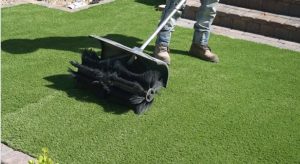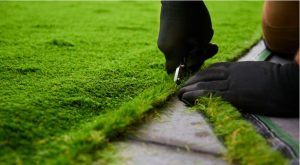Keeping your artificial grass clean and well-maintained enhances its aesthetic appeal and prolongs its lifespan. Whether you have a vibrant backyard oasis or a small balcony garden, regular cleaning is essential to ensure that your artificial turf remains in top-notch condition year-round.
This blog post will provide expert tips and techniques on how to clean artificial grass effectively. We’ve covered you, from brushing away debris to dealing with pet messes! So grab your tools, and let’s start achieving that pristine look for your synthetic lawn.
How to Clean Artificial Grass?

To effectively clean artificial grass, you’ll need a few essential tools. First and foremost, a sturdy brush is necessary to remove debris and keep the blades standing upright regularly. Additionally, having access to a hose or pressure washer will make washing away dirt and grime much easier. Remember to invest in gloves for protection during the cleaning process.
1. Brushing regularly
Brushing your artificial grass regularly is essential for keeping it clean and well-maintained. Use a stiff brush to remove debris, such as leaves and dirt, from the surface of the grass. This will help prevent buildup and keep your lawn fresh and inviting.
2. Washing with a hose or pressure washer
Washing with a hose or pressure washer is a great way to clean artificial grass. Spray the area with water and use a brush to scrub away any dirt or debris. This method helps remove stains and leaves your grass looking fresh and vibrant.
3. Removing leaves and weeds

Leaves and weeds can accumulate on artificial grass, affecting its appearance. To remove them, gently sweep the debris with a leaf blower or rake. Be careful not to damage the grass fibres while doing so. Regularly removing leaves and weeds will keep your artificial grass looking clean and pristine.
4. Cleaning up food spills immediately
Cleaning up food spills immediately is essential for maintaining the cleanliness of artificial grass. Food stains can attract pests and lead to unpleasant odours. Use a cloth or paper towel to blot up any spilled food, then rinse the area with water to remove any residue.
| Cleaning Step | Description |
| Brushing regularly | Use a stiff brush to remove debris, such as leaves and dirt, from the surface of the grass. This prevents buildup and maintains the grass’ freshness. |
| Washing with a hose or pressure washer | Spray the area with water and use a brush to scrub away dirt and debris. This method helps remove stains and keeps the grass vibrant. |
| Removing leaves and weeds | Gently sweep debris with a leaf blower or rake to prevent accumulation that affects appearance. Be careful not to damage the grass fibres. Regularly removing leaves and weeds keeps the grass clean and pristine. |
| Cleaning up food spills immediately | Use a cloth or paper towel to blot up spilled food, then rinse the area with water to remove any residue. Immediate cleanup is crucial to prevent attracting pests and odors due to food stains |
Cleaning Artificial Grass for Pets
Pets can bring joy to our lives but also leave a mess on artificial grass. Remove solid waste with gloves and a plastic bag to clean up after your furry friends. Then, rinse any remaining residue using a hose or pressure washer. Spray the area with an enzymatic cleaner to eliminate odours and bacteria. Keep your artificial grass looking fresh and pet-friendly!
Tips for Artificial Grass Maintenance

Clearing the Working Area
Before you start cleaning your artificial grass, clearing the working area of any obstacles is important. Remove any furniture, toys, or other items from the surface to ensure a thorough and efficient cleaning. This will allow you to have easy access to all areas of the grass and prevent any damage during the cleaning process.
Using a Hose or Pressure Washer
Using a hose or pressure washer is an effective way to clean artificial grass. Spray water across the surface, making sure to cover all areas. The strong force of the water will remove dirt and debris that may be stuck in the blades.
Getting Rid of Odors
Artificial grass can sometimes develop unpleasant odours, especially if pets use it frequently. To eliminate these smells, sprinkle baking soda over the surface and let it sit for a few hours before thoroughly brushing it in. This will help neutralize any odours and keep your artificial grass smelling fresh.
Allowing the Grass to Dry
After cleaning your artificial grass, allowing it to dry completely is important. This will prevent any moisture from getting trapped and potentially causing mould or mildew. Let nature do its job and air-dry the grass, ensuring good airflow.
Sweeping the Grass
Regularly sweeping your artificial grass is an essential part of maintenance. Use a stiff broom or brush to remove debris, such as leaves, twigs, and dirt that may have accumulated on the surface. This helps to keep the grass looking clean and prevents any potential damage or blockage in the drainage system.
What Not to Do When Cleaning Artificial Grass

Avoid harsh chemicals or bleach when cleaning artificial grass, as these can damage the fibers. Do not use a metal brush or rake, as this can cause tears in the turf. Do not leave standing water on the grass for prolonged periods; it can promote mould and mildew growth.
Conclusion
Keeping your artificial grass clean is essential for maintaining its appearance and longevity. Following the steps outlined in this article ensures that your artificial grass remains in top condition for years.
Regular brushing helps to keep the blades upright and prevent matting. Washing with a hose or pressure washer removes dirt and debris while refreshing the grass’s appearance. Removing leaves and weeds prevents them from causing damage or staining the surface. Cleaning up food spills immediately prevents stains from setting in.
When it comes to pets, regular maintenance is key. Remove solid waste promptly and rinse away any residue with water. Using pet-friendly detergents can help eliminate odours caused by urine. It’s also important to address other occurrences on artificial grass, such as oil spills or paint stains. Promptly remove these substances using appropriate cleaning agents recommended by the manufacturer.
To maintain your artificial grass effectively, avoid using harsh chemicals or abrasive tools that could damage the surface. Instead, opt for gentle cleaners and soft brushes specifically for synthetic turf. Remember to clear the working area before starting any cleaning routine, and always allow sufficient time for your artificial grass to dry after washing it with water or detergent solutions.
Sweeping regularly not only keeps your lawn looking neat but also helps prevent debris buildup between fibres. By incorporating these cleaning tips into your regular maintenance routine, you’ll be able to enjoy pristine-looking artificial grass year-round!
Now that you know the process of how to clean artificial grass properly, let’s ensure yours stays fresh all year!
FAQ
How often should I brush my artificial grass?
Regularly brushing your artificial grass is key to maintaining its freshness. Aim to brush the grass at least once a week to remove debris and keep the blades standing upright.
Can I use a pressure washer to clean my artificial grass?
Yes, using a pressure washer is an effective way to clean artificial grass. However, it’s important to adjust the pressure to a gentle setting to avoid damaging the turf fibers.
What should I do if my artificial grass develops odors?
If your artificial grass develops odors, sprinkle baking soda over the surface, let it sit for a few hours, and then brush it in thoroughly. This will help neutralize any odors and keep your grass smelling fresh.
How do I clean up food spills on artificial grass?
For food spills on artificial grass, immediately blot up the spilled food with a cloth or paper towel and rinse the area with water to remove any residue. Prompt cleanup helps prevent attracting pests and odors.
Is it safe to use pet-friendly detergents on artificial grass?
Yes, using pet-friendly detergents on artificial grass is safe and effective for eliminating odors and bacteria caused by pets. Ensure to rinse the area thoroughly after application.







